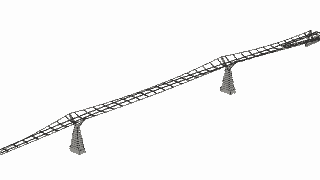Millennial wobbles
The Millennium Bridge across the Thames opened in June 2000 and was subsequently closed two days later because of the now-famous "wobbles". Given that, at any instant, two thousand people were suspended above a very dangerous river, this presented a serious problem.

One mode of oscillation
Courtesy of Cambridge University Dept of Engineering
It also presented a very interesting problem. The "wobbles" appeared to be caused by an unusual effect of synchronised walking. As the crowd walked at random across the bridge, it moved a little. This was to be expected: like all suspension bridges it is rather flexible. What was not expected was that these small motions would affect the way that the people walked and lead to a positive bio-feedback loop. Feeling the small motions underfoot, people adjusted their steps, possibly subconsciously, in order to walk more comfortably. This meant adjusting their footfall to move in synchronisation with what the bridge was doing. However, this reinforced the motion, leading to larger oscillations, which then caused more people to join in, and so forth.
This is not the old chestnut about soldiers needing to break step when crossing a suspension bridge. In the marching-soldiers problem, there is no change of gait. They merely feed energy directly into a vertical mode. On the Millennium Bridge, it is all about the way people CHANGED the way they were walking.
This phenomenon of phase synchronisation may be a new effect to engineers designing footbridges, but it is well known throughout the wider physical and biological sciences. One classic example is the behaviour of groups of fireflies. At dusk, the males of certain species land on the bushes on the riverbanks of Southeast Asia, all flashing at random, and then as the evening progresses, each male sees what the nearby males are doing and gradually adjusts its rate of flashing until, eventually, the whole bush is flashing on-off-on-off in perfect synchrony. If one flashes a torch at a bush of fireflies, one can entrain them to follow the flashing of the torch, and many interesting effects can be created. If the torch is flashed gradually faster, the fireflies can no longer keep up with it, and perform instead an interesting quasiperiodic behaviour - here it comes, faster, faster, faster - oh, we missed it, let's slow down and wait for it to come round again, here it comes, faster, faster... and so on.
There are many other examples: the menstrual synchrony of groups of females living in close proximity, the fact that we only ever see the same face of the moon, the synchronisation of two pendulum clocks on a shelf, the behaviour of coupled electronic oscillators and so forth.
The similarity between the firefly bush and the crowded bridge is not just a poetic resonance but a useful mathematical analogue. In order to understand what is happening on the bridge, the engineers would do well to read what the mathematicians have written about the fireflies.
About the author
Allan McRobie is Reader in Structural Engineering at the University of Cambridge with a particular interest in bridge dynamics.